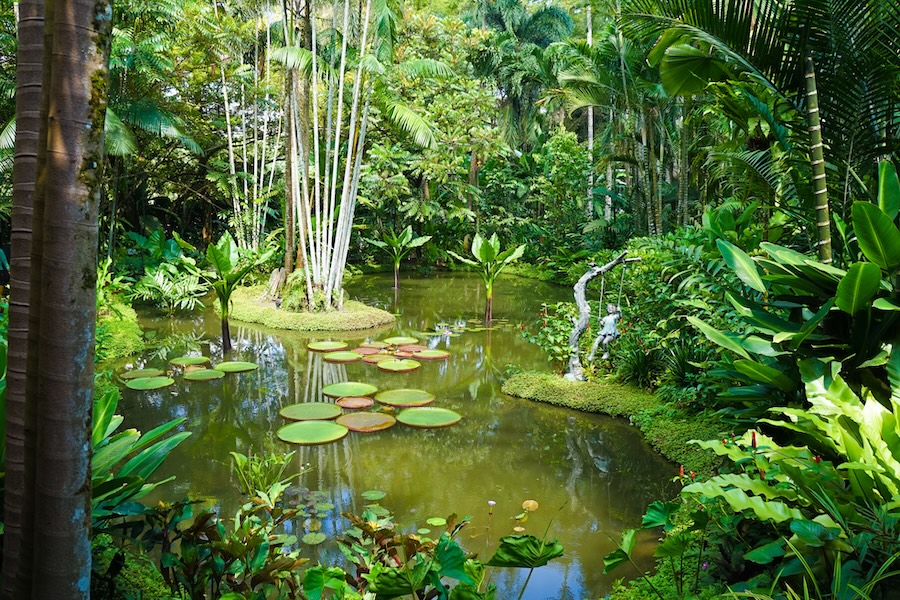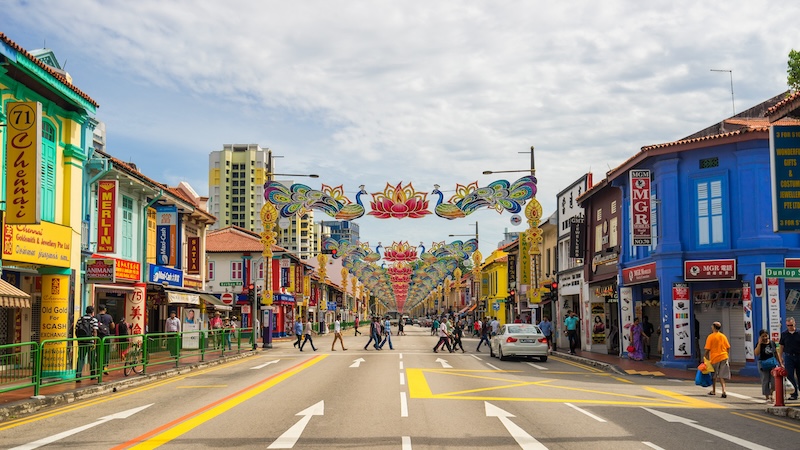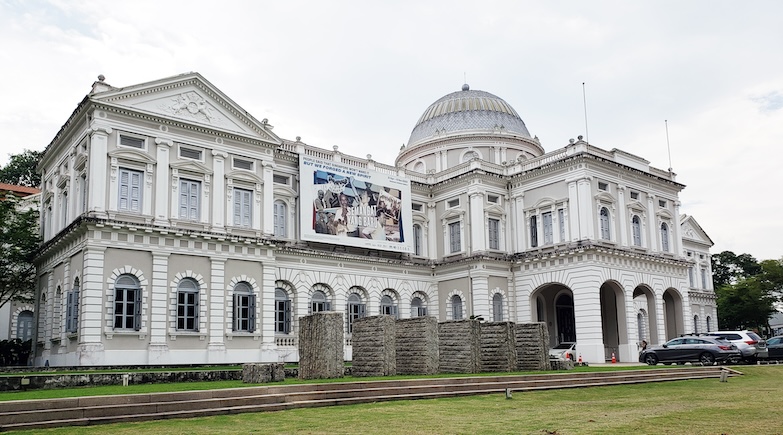The bustling city-state of Singapore is not a place that most people would think of when planning a vacation. After all, it is a pricey business hub known more for its historic spice trade and strict contemporary social policies than for its tourism. Look below the surface, though, and along with its modern, global identity, you will find a country rich in history and culture.
Singapore is a tropical island off the south coast of Malaysia, at the end of the long peninsula that includes Myanmar and Thailand. It is only about 50 km from east to west and 27 km from north to south, but it is home to almost six million people.
Today’s residents are mostly Chinese, Indian, Malay, and Eurasian, and this kind of multicultural community seems to have existed for a long time. Written records reveal that Singapore was a busy trading hub as early as the 1400s, and archaeological artifacts provide evidence of trading Chinese porcelain and stoneware, along with locally made pottery and laka wood that was used as incense.
Trade at the port of Singapore increased significantly after the Portuguese explorer Vasco da Gama mapped a nautical trading route from Europe to the island in the late 1400s. This route provided spice traders with an alternative to the overland Silk Road that joined Asia with the Mediterranean, and which was later followed by Dutch and British traders.
The port of Singapore, which now covers a number of waterfront sites, has grown to be one of the biggest in the world and has continued to support the trade and commerce that it has always been known for. Part of that development has benefited from the “land reclamation,” an extraordinary and controversial initiative that has expanded the land area by about 25% since independence in 1965.

Botanical Gardens, UNESCO Heritage Site – Shutterstock Photo
Despite all the development, the island is still largely green, and preserves such amazing sights as the Botanical Gardens, the first UNESCO Heritage Site in Singapore. The rain forest that the gardens contain is one of only two in the world that is within city borders, the other being in Rio de Janeiro. The gardens are a short bus ride from the central business district.
Evidence of the local cultures can be found in the ethnic enclaves of the city. Tour Serangoon Road, for example, to experience the colours, art, and aromas of Little India. Or visit lively Chinatown, the Islamic district of Kampong Glam, or Little Korea. All provide a wonderful insight into the people who call Singapore home. See KNYCXJourneying.com for plenty of good information.

Little India – Shutterstock Photo
One convenient way to get an overview of these enclaves, and to the whole southeast part of the nation, is to take one of the hop-on, hop-off bus tours that are offered. These tours will also take you through the streets where the office towers rise up next to the colonial-era Raffles Hotel, past the towering Gardens by the Bay ornamental flowers that light up at night, and the opulent Marina Bay Sands Casino.
Along with the bold new building designs, Singapore has preserved a lot of the architecture from its early days, in some cases building around and even over it. It is a very safe and walkable city, and travelling on foot is also a good way to experience the scale of the old and the new, as well as the buzz of the shopping district of Orchard Mall. For the more adventurous, add the cable car ride to your schedule.

National Museum of Singapore – Photo by Alan Boreham
I can also recommend the National Museum of Singapore for its excellent exhibits that bring to life the history and evolution of the community through its trading, foreign influence, power struggles, and war that played such important roles in the forging of the current democracy.
One of the highlights for foodies is the extensive variety of food and food venues on offer. From classic ethnic fare to modern fusion, and from fashionable restaurants to street carts, you have to explore the amazing taste experiences, either on your own or by taking one of the many food tours that are available.
At the time of writing, the Singapore dollar was approximately equivalent in value to the Canadian dollar, or about SIN 0.75 to the US dollar. With that knowledge, you should be aware of some local laws.
It’s true that jaywalking is an offence, and violators will likely receive a $50 fine for the first offence, and a fine of up to $1000 for a repeat offence. The law is similar for littering. The fine for a first offence is up to $1000 and up to $2000 for a subsequent offence, plus a few hours of community service spent picking up litter in a public space. Needless to say, Singapore is spotless.

British Colonial Style Raffles Hotel – Photo by Alan Boreham
As noted above, Singapore is relatively expensive compared to other destinations in the region. And like anywhere, costs may be higher at the most popular times, or around special events like the Formula 1 Grand Prix car race in September. I was there just a few days before the race and found it hard to find a reasonable hotel near the city centre for under $300 a night.
You should also be aware that costs for retail sales and services in Singapore are often listed as the price followed by “+ +,” expressed as plus plus. That means that the item or service will cost the listed price plus a Goods and Services Tax (8% at the time of writing) plus a Service Charge of 10%. Prices that are shown as “nett” have both charges included. Confusing? I found that people in the shops and restaurants are happy to explain.

Architecture Respecting Nature – Photo by Alan Boreham
Business-like Singapore apparently has the highest adoption rate of cashless payments in Southeast Asia. However, you should be aware that some merchants, including taxis, in my experience, also impose a surcharge if you use a credit card. So while the plus plus is unavoidable, experienced travellers I talked to suggested taking enough cash to avoid the credit card surcharge. If unsure of whether there is one, it’s always best to ask ahead of time.
When it comes to paying cash, except for hotels, airports, and some tourist establishments, businesses will usually only accept the Singapore dollar. Some will accept the US dollar or British pound. Again, ask beforehand to avoid an embarrassing situation.
It’s useful to know that tipping is not customary in Singapore and is not allowed at the airport.
Travellers I met were often adding a few days to a work event. I feel that a stay of three to five days is enough to gain a good familiarity with the place, and a longer holiday would allow time to immerse oneself in a particular interest. With over 1000 species of orchids at the National Orchid Garden of the Botanical Gardens, for instance, an avid horticulturist could be distracted for days.
Helen at CuriousGooseTravel.com offers excellent suggestions for itineraries for one, three, and five-day visits.
Perhaps the best opportunity to visit Singapore is to include it in an itinerary for travel to other parts of the Asia Pacific region, such as Australia, Thailand, Vietnam, Cambodia, or China. A number of airlines serve the Changi airport, and Singapore Airlines was voted the best airline in the world in 2023.
ABOUT THE AUTHOR
Alan Boreham
Alan is a world traveller and co-author of the memoir Beer in the Bilges, Sailing Adventures in the South Pacific.
This article is featured in Canadian Teacher Magazine’s Winter 2024 issue.











